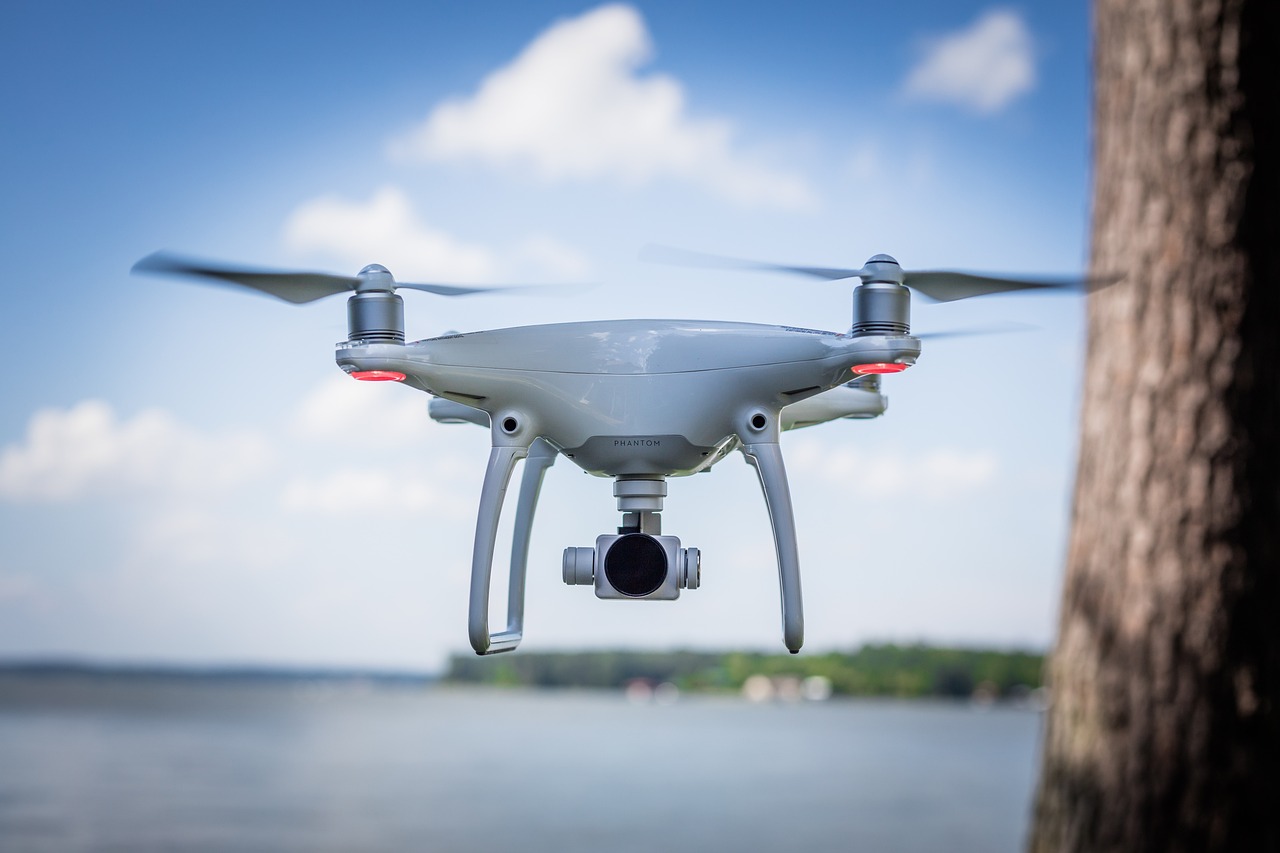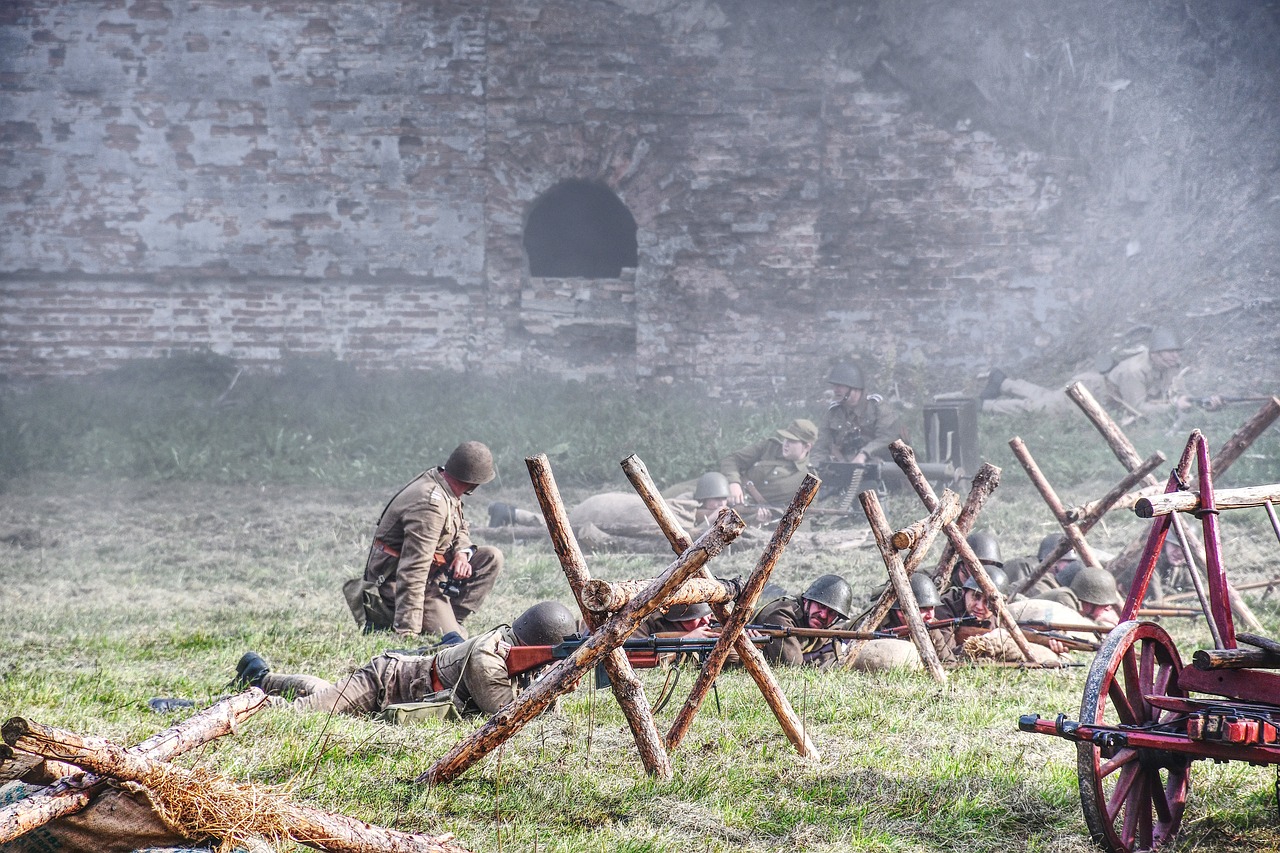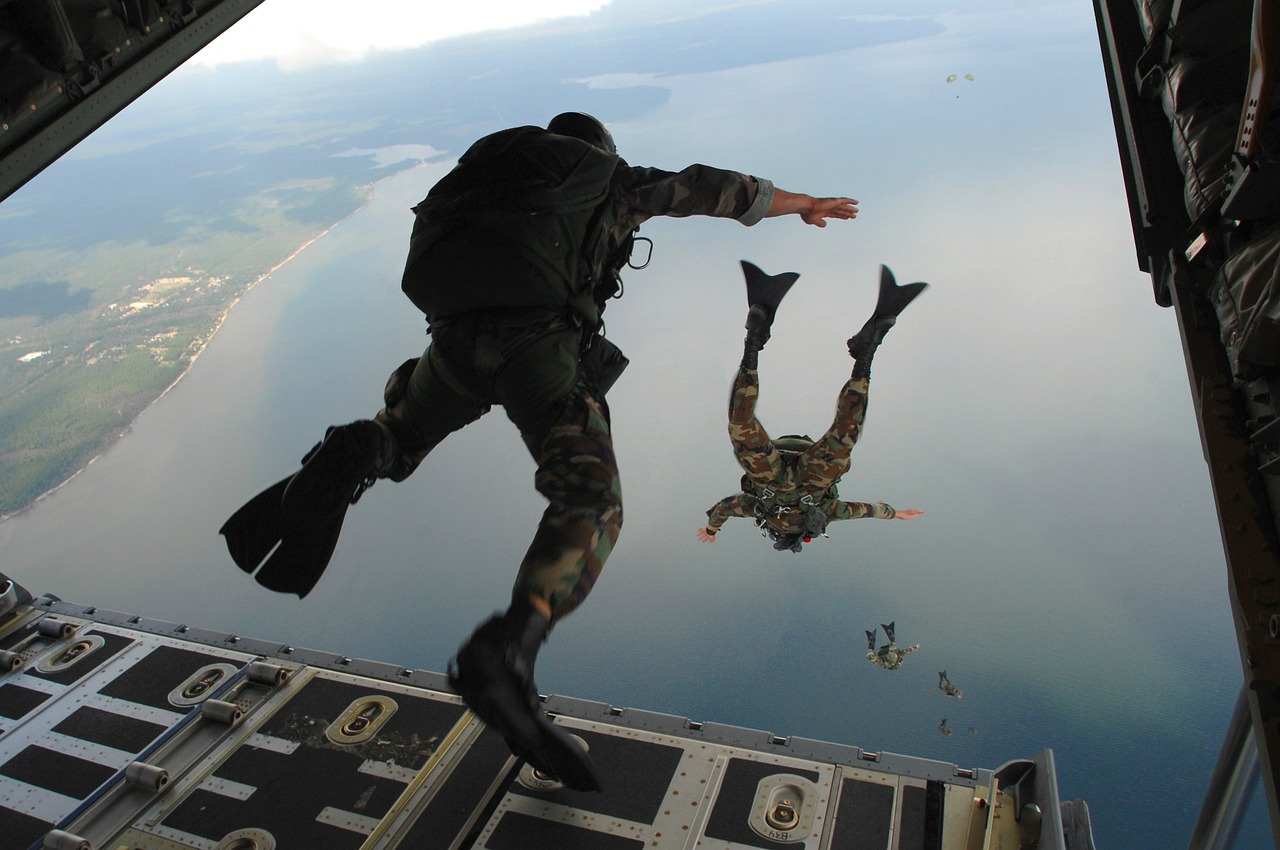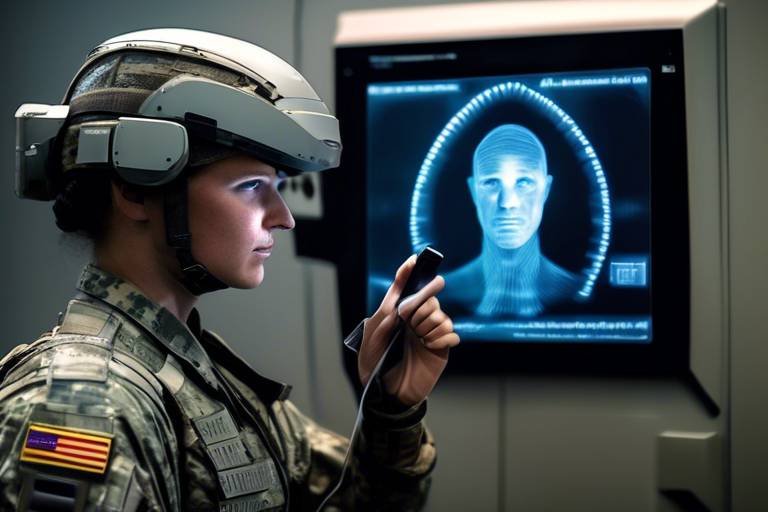AI and Fire Control Systems - Increasing Combat Efficiency
In today's fast-paced military landscape, the integration of artificial intelligence (AI) into fire control systems is nothing short of revolutionary. Imagine a battlefield where decisions are made in milliseconds, where every shot fired is calculated with pinpoint accuracy, and where the chaos of combat is tamed by advanced technology. This is not a scene from a futuristic movie; it is the reality of modern warfare as AI enhances the capabilities of fire control systems. By streamlining processes, improving decision-making, and optimizing overall combat effectiveness, AI is transforming how military operations are conducted. In this article, we will dive deep into the various facets of AI in fire control systems and explore how it leads to more successful missions.
Fire control systems are the backbone of military operations, acting as the brain behind targeting and engaging threats. Think of them as the conductor of an orchestra, ensuring that every instrument (or weapon) plays in harmony. These systems consist of several critical components, including sensors, processors, and weaponry, all working together to deliver precision strikes. The significance of fire control systems in modern warfare cannot be overstated; they integrate seamlessly with various weaponry, enabling forces to respond to threats swiftly and effectively. Without these systems, the fog of war would be even more daunting, making it challenging to achieve mission objectives.
The advent of AI has revolutionized fire control systems, automating processes that were once manual and labor-intensive. Imagine having a highly intelligent assistant that never tires, constantly analyzing data from multiple sources to identify targets. AI excels in target recognition, tracking, and engagement, which translates into faster response times on the battlefield. This capability is crucial when every second counts and could mean the difference between mission success and failure. With AI, fire control systems are not just reactive; they become proactive, anticipating threats before they materialize.
One of the most significant advantages of AI in fire control systems is its ability to process vast amounts of data in real time. Picture a giant digital brain that can sift through information from various sensors, such as radar, infrared, and satellite feeds, to create a comprehensive picture of the battlefield. This enhanced situational awareness allows commanders to make informed decisions quickly. Efficient data analysis leads to better decision-making in combat scenarios, ensuring that military personnel can focus on executing their missions rather than getting bogged down by information overload.
At the heart of AI's capabilities in fire control systems are machine learning techniques. These techniques enable systems to learn from past engagements, adapting and improving over time. Imagine teaching a child to ride a bike: the more they practice, the better they become. Similarly, fire control systems equipped with machine learning can refine their targeting algorithms based on historical data, enhancing their effectiveness in future operations. This continuous learning process is vital for maintaining a tactical edge in an ever-evolving battlefield.
Another powerful application of AI in fire control systems is predictive analytics. By leveraging historical data, predictive analytics can forecast potential threats and outcomes, allowing commanders to make informed tactical decisions. For example, if a particular enemy movement pattern has been observed in previous engagements, AI can alert commanders to the likelihood of a similar move occurring again. This foresight enables military leaders to prepare and respond proactively, significantly increasing the chances of mission success.
Integrating AI into existing fire control systems presents both challenges and opportunities. While the compatibility of AI technologies with legacy systems can be complex, the benefits of modernizing military infrastructure are undeniable. By upgrading older systems with AI capabilities, military forces can enhance their operational effectiveness without starting from scratch. This integration allows for a smoother transition into the future of warfare, where AI plays an increasingly pivotal role.
One of the most significant impacts of AI-driven fire control systems is the remarkable improvement in targeting accuracy and efficiency. Imagine being able to hit a bullseye every time you take a shot. AI advancements lead to reduced collateral damage and increased mission success rates, which are critical in modern warfare where civilian lives are often at stake. With AI, the precision of fire control systems ensures that military operations can be conducted with minimal unintended consequences.
AI-powered real-time targeting solutions offer rapid adjustments during engagements, enhancing operational effectiveness in dynamic combat environments. Consider a scenario where enemy positions are constantly shifting; AI can analyze these movements and provide updated targeting solutions in real-time. This agility ensures that military forces can adapt to changing circumstances, maintaining the upper hand in engagements.
Analyzing real-world case studies reveals the profound impact of AI on fire control systems. For instance, during recent military operations, AI-enhanced fire control systems have demonstrated their ability to increase accuracy and reduce response times significantly. Lessons learned from these applications provide invaluable insights that can further refine AI technologies and their integration into military strategies worldwide.
- What are fire control systems? Fire control systems are integrated systems that assist military forces in targeting and engaging threats with precision.
- How does AI improve fire control systems? AI enhances fire control systems by automating processes, improving data analysis, and enabling faster decision-making.
- What role does machine learning play? Machine learning allows fire control systems to learn from past engagements, improving their targeting algorithms over time.
- Can AI integrate with legacy systems? Yes, integrating AI into existing fire control systems can modernize military infrastructure, providing enhanced capabilities.
- What are the benefits of AI in combat? AI-driven systems improve targeting accuracy, reduce collateral damage, and increase overall mission success rates.

Understanding Fire Control Systems
Fire control systems are the backbone of modern military operations, serving as the critical link between detection, targeting, and engagement of threats. Imagine a complex web of technology that seamlessly integrates various components to ensure that every shot fired has a higher chance of hitting its mark. These systems encompass a range of technologies, including radar, sensors, and computers, all working together to provide real-time information to military personnel. The significance of fire control systems cannot be overstated; they are essential for maximizing combat effectiveness and minimizing risks to friendly forces.
At their core, fire control systems consist of several key components:
- Target Acquisition: This involves identifying and locating potential threats using advanced sensors and surveillance technologies.
- Tracking: Once a target is acquired, the system continuously monitors its movement to ensure accurate targeting.
- Engagement: This is the process of launching an attack, which can involve various types of weaponry, from missiles to artillery.
- Feedback Loop: After engagement, data is collected to assess the effectiveness of the strike and inform future operations.
The integration of these components allows fire control systems to operate efficiently in dynamic combat environments. For instance, when a threat is detected, the system quickly analyzes the data and determines the best course of action, whether it's engaging the target or repositioning for a better angle. This rapid decision-making is crucial, as it can mean the difference between mission success and failure.
Moreover, fire control systems are designed to work with various types of weaponry, from ground-based artillery to naval guns and air-to-ground missiles. This versatility is essential in modern warfare, where joint operations between different branches of the military are increasingly common. By integrating with existing weapon systems, fire control technologies enhance the overall effectiveness of military operations.
In summary, understanding fire control systems is fundamental to grasping how modern militaries operate. These systems not only improve accuracy and efficiency but also play a vital role in ensuring the safety of personnel on the battlefield. As technology continues to evolve, the future of fire control systems looks promising, particularly with the integration of artificial intelligence, which will further enhance their capabilities.
- What are fire control systems? Fire control systems are technologies used by militaries to detect, track, and engage threats effectively.
- How do fire control systems improve combat effectiveness? They enhance decision-making speed, targeting accuracy, and overall operational efficiency.
- What role does AI play in fire control systems? AI automates processes and analyzes data to improve targeting and response times.
- Can fire control systems integrate with existing military technology? Yes, they are designed to work with various weapon systems and enhance their capabilities.

The Role of AI in Fire Control
Artificial intelligence is not just a buzzword; it’s a game-changer in the realm of fire control systems. Imagine having a partner that can analyze mountains of data in seconds, pinpointing threats and making decisions faster than any human could. This is exactly what AI brings to the table, revolutionizing how military operations are conducted. By automating mundane tasks and enhancing data analysis, AI transforms fire control systems into powerful tools that significantly boost combat effectiveness.
One of the most remarkable capabilities of AI in fire control systems is its ability to recognize and track targets with unparalleled precision. Traditional systems often rely on human operators to make critical decisions, which can lead to delays and errors, especially in high-pressure situations. AI, on the other hand, can process visual data from various sensors, identifying potential threats almost instantaneously. This rapid recognition not only speeds up the engagement process but also ensures that the right targets are prioritized, reducing the risk of collateral damage.
To illustrate this point, consider the following table that summarizes the key advantages of AI in fire control:
| Feature | Traditional Fire Control | AI-Enhanced Fire Control |
|---|---|---|
| Data Processing Speed | Slow, manual analysis | Real-time, automated processing |
| Target Recognition | Human-dependent | AI-driven accuracy |
| Decision-Making | Potentially delayed | Instantaneous and informed |
| Adaptability | Static responses | Dynamic learning and adaptation |
Furthermore, the integration of AI allows for real-time adjustments during combat scenarios. Imagine a scenario where a military unit is engaged in a rapidly changing battlefield. AI algorithms can analyze incoming data from drones, satellites, and ground sensors, allowing commanders to adjust their strategies on the fly. This level of operational flexibility is crucial in modern warfare, where the landscape can shift dramatically in mere seconds.
Another fascinating aspect of AI in fire control is its machine learning capabilities. These systems learn from past engagements, identifying patterns and improving their performance over time. Think of it as a soldier who learns from each battle, becoming more adept at recognizing threats and making tactical decisions. This continuous learning process not only enhances the effectiveness of fire control systems but also ensures that they remain relevant in the face of evolving combat scenarios.
Moreover, AI's predictive analytics can forecast potential threats and outcomes based on historical data. This capability aids commanders in making informed tactical decisions, allowing them to anticipate enemy movements and prepare accordingly. It’s like having a crystal ball that provides insights into future engagements, enabling military leaders to stay one step ahead.
In summary, the role of AI in fire control systems is transformative, enhancing every aspect from target recognition to decision-making. As we delve deeper into this technological revolution, it’s clear that the integration of AI not only improves efficiency but also increases the likelihood of mission success. The future of combat is here, and AI is at the forefront of this evolution.
- How does AI improve target recognition in fire control systems?
AI uses advanced algorithms to analyze data from various sensors, allowing for rapid and accurate identification of potential threats. - What are the benefits of integrating AI into legacy fire control systems?
Integrating AI enhances the capabilities of existing systems, improving decision-making speed, accuracy, and overall effectiveness in combat scenarios. - Can AI systems adapt to new combat environments?
Yes, AI systems utilize machine learning techniques to adapt based on previous engagements, making them more effective in diverse combat situations.

Data Processing and Analysis
The integration of artificial intelligence (AI) into fire control systems has transformed the landscape of military operations, particularly in the realm of . In today's fast-paced combat scenarios, the ability to process vast amounts of data in real-time is not just an advantage; it's a necessity. Traditional methods of data analysis often fall short when faced with the complexities of modern warfare, leading to potential delays in decision-making. However, AI algorithms excel in this area by rapidly analyzing data from various sensors, including radar, infrared, and even satellite imagery.
Imagine being in the heat of battle, where every second counts. AI acts like a seasoned navigator, sifting through mountains of information in the blink of an eye, ensuring that commanders have the most accurate and up-to-date information at their fingertips. This capability significantly enhances situational awareness, allowing military personnel to make informed decisions swiftly. For instance, AI can analyze patterns in enemy movements, predict potential threats, and recommend tactical maneuvers—all in real-time. This level of responsiveness can mean the difference between success and failure on the battlefield.
Moreover, the data processing capabilities of AI extend beyond mere analysis. They also include the ability to learn from past engagements. By employing machine learning techniques, fire control systems can adapt and improve over time. This means that the more data these systems process, the better they become at predicting outcomes and recognizing patterns. For example, if a particular strategy has proven successful in previous missions, the system can recommend similar tactics in future engagements, thereby enhancing overall combat effectiveness.
To illustrate the impact of AI on data processing, consider the following table that summarizes the key advantages of AI-driven analysis in fire control systems:
| Advantage | Description |
|---|---|
| Speed | AI processes data in real-time, providing immediate insights for decision-making. |
| Accuracy | Enhanced algorithms reduce errors in target identification and threat assessment. |
| Adaptability | Machine learning enables systems to learn from past experiences and improve over time. |
| Predictive Capabilities | AI can forecast potential threats based on historical data, aiding strategic planning. |
In conclusion, the role of AI in processing and analyzing data within fire control systems cannot be overstated. By providing real-time insights, enhancing accuracy, and learning from previous engagements, AI empowers military forces to respond effectively to dynamic combat situations. As technology continues to evolve, we can expect even greater advancements in how data is utilized in warfare, ultimately leading to more successful missions and improved safety for military personnel.
- How does AI improve decision-making in combat?
AI enhances decision-making by analyzing vast amounts of data quickly, providing commanders with real-time insights and recommendations based on historical patterns and current situations.
- What types of data does AI analyze in fire control systems?
AI analyzes data from various sources, including radar, infrared sensors, satellite imagery, and even social media feeds, to create a comprehensive picture of the battlefield.
- Can AI systems learn from past military engagements?
Yes, AI systems utilize machine learning techniques to learn from previous engagements, allowing them to adapt strategies and improve their performance over time.
- What are the potential risks of relying on AI in military operations?
While AI offers significant advantages, risks include over-reliance on technology, potential system failures, and ethical considerations regarding autonomous decision-making in combat scenarios.

Machine Learning Techniques
When we talk about machine learning in the context of fire control systems, we're diving into a world where technology learns and evolves, much like a seasoned soldier gaining experience on the battlefield. These systems utilize algorithms that allow them to analyze data, recognize patterns, and make predictions based on past engagements. Imagine a soldier who, after each mission, reflects on their decisions and adjusts their strategies accordingly; that's exactly how machine learning enhances fire control systems.
One of the core techniques employed is supervised learning, where the system is trained on a labeled dataset. For instance, if we feed the system data about various targets, including their characteristics and previous engagement outcomes, it learns to identify similar targets in real-time. This method is akin to teaching a recruit the ropes by showing them what a successful mission looks like, enabling them to replicate that success in future operations.
Another vital technique is unsupervised learning, which allows the system to find hidden patterns in data without prior labeling. This is particularly useful in identifying new threats or unexpected changes in the battlefield landscape. Think of it as a scout who, without any guidance, learns to navigate the terrain and recognize potential ambush points just by observing their surroundings. This adaptability is crucial in a rapidly changing combat environment.
Furthermore, reinforcement learning plays a significant role in refining fire control systems. In this approach, algorithms learn through trial and error, receiving feedback based on their actions. For example, if a targeting decision leads to a successful engagement, the system reinforces that decision, while poor outcomes lead to adjustments. It's similar to a pilot in a flight simulator who learns to make better decisions by experiencing the consequences of their actions in a controlled environment.
To illustrate the impact of these techniques, consider the following table that summarizes the key machine learning techniques and their applications in fire control systems:
| Technique | Description | Application |
|---|---|---|
| Supervised Learning | Trains on labeled data to identify and predict outcomes. | Target recognition based on historical data. |
| Unsupervised Learning | Finds patterns in unlabeled data. | Identifying new threats and anomalies. |
| Reinforcement Learning | Learns through trial and error with feedback. | Optimizing engagement strategies based on outcomes. |
In conclusion, the integration of these machine learning techniques into fire control systems not only enhances their effectiveness but also ensures that they remain adaptable to the ever-changing dynamics of modern warfare. As these systems continue to learn and evolve, we can expect a significant boost in operational efficiency and mission success rates.
- What is machine learning in fire control systems? - Machine learning refers to the use of algorithms that enable fire control systems to learn from data, improving their decision-making capabilities over time.
- How does supervised learning work? - Supervised learning trains a system on labeled datasets, allowing it to recognize and predict outcomes based on past data.
- What are the benefits of using unsupervised learning? - Unsupervised learning helps identify new patterns and threats without prior knowledge, enhancing situational awareness.
- Can reinforcement learning improve combat strategies? - Yes, reinforcement learning allows systems to learn from their actions and outcomes, optimizing engagement strategies for better results.

Predictive Analytics in Combat
Predictive analytics is like having a crystal ball in the chaotic world of combat. It utilizes historical data, advanced algorithms, and machine learning to forecast potential threats and outcomes, providing military commanders with a significant advantage on the battlefield. Imagine being able to anticipate enemy movements or identify emerging threats before they become critical. This capability transforms the way military operations are planned and executed, making them not only more efficient but also safer for personnel involved.
At its core, predictive analytics in combat involves analyzing vast amounts of data from various sources, including past engagements, troop movements, and even environmental factors. By processing this information, AI systems can identify patterns and trends that might not be immediately obvious to human analysts. For instance, if a certain type of attack has historically been more successful under specific conditions, predictive analytics can alert commanders to prepare for similar scenarios in the future.
One of the most exciting aspects of predictive analytics is its ability to enhance decision-making in real-time. For example, during a military operation, AI can continuously analyze incoming data and adjust predictions based on new information. This dynamic approach allows commanders to make informed tactical decisions that can significantly alter the outcome of an engagement. The following table illustrates how predictive analytics can enhance various aspects of combat operations:
| Aspect | Traditional Approach | Predictive Analytics |
|---|---|---|
| Threat Identification | Reactive analysis based on past events | Proactive identification using real-time data |
| Resource Allocation | Static planning | Dynamic adjustments based on predicted needs |
| Operational Planning | Fixed strategies | Adaptive strategies based on evolving data |
Furthermore, predictive analytics can assist in training scenarios, helping military personnel prepare for a variety of situations based on historical data. By simulating potential future engagements, soldiers can practice their responses to various threats, ultimately increasing their readiness and effectiveness. This approach not only enhances individual performance but also strengthens teamwork and coordination among units.
In conclusion, the integration of predictive analytics into combat operations represents a significant leap forward in military strategy. It empowers commanders with the foresight needed to make better decisions, allocate resources more effectively, and adapt to the ever-changing dynamics of warfare. As technology continues to evolve, the potential for predictive analytics to shape the future of combat remains immense, paving the way for more successful and efficient military missions.
- What is predictive analytics? Predictive analytics is a branch of advanced analytics that uses historical data, machine learning, and algorithms to predict future outcomes.
- How does predictive analytics improve military operations? It enhances decision-making by providing real-time insights, anticipating threats, and optimizing resource allocation.
- Can predictive analytics be used in non-military applications? Yes, it is widely used in various fields, including finance, healthcare, and marketing, for forecasting and strategic planning.
- What are the challenges of implementing predictive analytics in combat? Challenges include data integration from various sources, ensuring data accuracy, and training personnel to interpret predictive insights effectively.

Integration with Existing Systems
Integrating artificial intelligence (AI) into existing fire control systems is a complex yet crucial endeavor for modern military operations. As the battlefield evolves, the integration of cutting-edge technology with legacy systems can significantly enhance operational capabilities. However, this integration is not without its challenges. One of the primary hurdles is ensuring compatibility between new AI technologies and older systems that may not have been designed to accommodate such advancements.
Legacy systems often come with outdated software and hardware that can limit their ability to process the advanced algorithms that AI utilizes. This can lead to issues such as data bottlenecks and inefficient communication between systems. To overcome these obstacles, military organizations must invest in upgrading infrastructure and employing middleware solutions that act as a bridge between the old and new technologies. By doing so, they can create a more cohesive environment where AI can thrive and improve fire control operations.
Moreover, the integration process also involves extensive training for personnel. Soldiers and operators must be familiar with both the legacy systems and the new AI-driven tools. This training not only enhances their technical skills but also fosters a deeper understanding of how to leverage AI for improved decision-making on the battlefield. As the saying goes, "a chain is only as strong as its weakest link," and in this case, the human element is just as critical as the technology itself.
Despite the challenges, the benefits of integrating AI into fire control systems are undeniable. Enhanced situational awareness, improved targeting accuracy, and faster response times are just a few of the advantages that can be realized. For instance, AI can analyze data from various sensors in real-time, providing operators with actionable insights that can lead to more effective engagement strategies.
To illustrate the impact of AI integration, consider the following table that outlines key benefits:
| Benefit | Description |
|---|---|
| Improved Decision-Making | AI algorithms can process vast amounts of data to present operators with the best courses of action. |
| Enhanced Targeting Accuracy | AI systems can analyze target data to minimize collateral damage and increase mission success rates. |
| Faster Response Times | Real-time data processing allows for quicker adjustments during engagements, improving operational effectiveness. |
In conclusion, while the integration of AI into existing fire control systems poses certain challenges, the potential benefits far outweigh these obstacles. By modernizing military infrastructure and ensuring that personnel are well-trained, military organizations can leverage AI technologies to significantly enhance their combat capabilities. As we move forward, the successful integration of these systems will be pivotal in maintaining a competitive edge on the battlefield.
- What are the main challenges of integrating AI into existing fire control systems?
The main challenges include ensuring compatibility with legacy systems, upgrading infrastructure, and training personnel to effectively use new technologies.
- How does AI improve decision-making in military operations?
AI enhances decision-making by processing vast amounts of data quickly, providing operators with actionable insights and the best courses of action in real-time.
- Can legacy systems be upgraded to support AI integration?
Yes, legacy systems can often be upgraded through middleware solutions and infrastructure enhancements to support AI technologies.
- What role does training play in the integration process?
Training is crucial as it ensures that personnel are familiar with both legacy and new AI-driven systems, enhancing their ability to leverage technology effectively.

Enhancing Accuracy and Efficiency
In the ever-evolving landscape of modern warfare, accuracy and efficiency are paramount. The integration of artificial intelligence (AI) into fire control systems represents a significant leap forward in achieving these critical objectives. Imagine the battlefield as a complex chessboard, where every move counts and the stakes are incredibly high. Just as a chess master anticipates their opponent's moves, AI-driven systems can predict and react to threats with remarkable precision.
AI enhances targeting accuracy by utilizing advanced algorithms that analyze data from multiple sources. This means that instead of relying solely on human judgment, which can be prone to error, fire control systems can process vast amounts of information in real time. For instance, AI can sift through sensor data, satellite imagery, and intelligence reports to identify potential targets with a level of detail and speed that humans cannot match. This capability not only increases the likelihood of hitting the intended target but also minimizes the risk of collateral damage, a crucial consideration in urban warfare scenarios.
Furthermore, the efficiency of fire control operations is significantly improved through AI's ability to make rapid adjustments during engagements. Traditional systems often require manual input and lengthy decision-making processes, which can be detrimental in fast-paced combat situations. AI, on the other hand, can analyze changing conditions—such as the movement of enemy forces or the impact of environmental factors—almost instantaneously. This dynamic adaptability allows military personnel to respond to threats more effectively, ensuring that every second counts.
Let’s take a closer look at some of the specific advancements that AI brings to fire control systems:
| Advancement | Description |
|---|---|
| Automated Target Recognition | AI systems can identify and classify targets based on predefined criteria, reducing the chances of misidentification. |
| Real-time Data Processing | AI can analyze incoming data from various sensors, providing commanders with up-to-the-minute situational awareness. |
| Adaptive Learning | Machine learning techniques allow AI systems to improve their performance over time by learning from past engagements. |
Moreover, the implementation of AI in fire control systems is not just about enhancing current capabilities; it also paves the way for future innovations. As technology continues to advance, we can expect even more sophisticated applications of AI that will further refine the accuracy and efficiency of military operations. For example, the potential for predictive analytics to forecast enemy movements based on historical data could transform strategic planning and execution on the battlefield.
In conclusion, the integration of AI into fire control systems is revolutionizing military operations. By enhancing accuracy and efficiency, these systems are not only increasing mission success rates but also ensuring that military personnel can operate with greater confidence and safety. As we continue to explore the capabilities of AI, it’s clear that the future of combat will be defined by the ability to harness technology in ways that were once unimaginable.
- How does AI improve targeting accuracy in fire control systems?
AI processes vast amounts of data from various sources to identify and classify targets, minimizing human error and enhancing precision. - What role does real-time data processing play in combat efficiency?
Real-time data processing allows military personnel to make informed decisions quickly, adapting to dynamic battlefield conditions. - Can AI systems learn from past engagements?
Yes, machine learning techniques enable AI to analyze previous combat scenarios and improve its decision-making capabilities over time.

Real-time Targeting Solutions
In the fast-paced world of modern warfare, have become a game-changer. Imagine being able to adjust your aim while in the heat of battle, just like a skilled archer who can tweak their shot mid-flight to hit a moving target. This is precisely what AI-driven fire control systems enable. By leveraging advanced algorithms and instantaneous data processing, these systems provide military personnel with accurate targeting information that adapts to changing conditions on the battlefield.
One of the most remarkable features of real-time targeting solutions is their ability to process data from multiple sources, including drones, satellites, and ground sensors. This integration creates a comprehensive picture of the battlefield, allowing commanders to make informed decisions swiftly. For example, when a target is identified, the system can calculate the optimal firing solution, taking into account factors such as wind speed, distance, and even the trajectory of the target. This level of precision not only increases the likelihood of a successful hit but also minimizes the risk of collateral damage, which is a critical concern in urban combat scenarios.
Moreover, the adaptability of these solutions is paramount. In dynamic combat environments, situations can change in the blink of an eye. AI-powered systems can analyze real-time data to adjust targeting parameters automatically. For instance, if an enemy vehicle suddenly changes direction, the system can recalibrate the targeting solution almost instantaneously, ensuring that the response remains effective. This capability is akin to having a personal assistant who not only understands your needs but also anticipates them, making sure you are always one step ahead.
To illustrate the effectiveness of real-time targeting solutions, consider the following table that highlights key advantages:
| Advantage | Description |
|---|---|
| Increased Accuracy | Real-time data processing allows for precise targeting, reducing the likelihood of missing the intended target. |
| Faster Response Times | AI systems can quickly analyze and adapt to changing battlefield conditions, enabling rapid adjustments to targeting. |
| Reduced Collateral Damage | By improving targeting accuracy, these systems help minimize unintended damage to civilians and infrastructure. |
| Enhanced Situational Awareness | Integration of data from various sources provides a comprehensive view of the battlefield, aiding decision-making. |
In addition to the technological advancements, the human element remains crucial. Operators must be trained to interpret the data provided by these systems effectively. While AI can offer unparalleled support, the final decision-making still lies with skilled personnel who understand the complexities of combat. This collaboration between man and machine is what truly enhances operational effectiveness.
In conclusion, real-time targeting solutions powered by AI represent a significant leap forward in military capability. They empower armed forces to respond to threats with unmatched precision and speed, ultimately leading to more successful missions. As technology continues to evolve, we can expect these systems to become even more sophisticated, further reshaping the landscape of modern warfare.
- What are real-time targeting solutions? Real-time targeting solutions are advanced systems that use AI to provide accurate targeting information and adapt to changing battlefield conditions.
- How do AI systems improve targeting accuracy? AI systems analyze data from various sensors and sources to calculate optimal firing solutions, taking multiple factors into account.
- What is the significance of reducing collateral damage? Reducing collateral damage is crucial for maintaining ethical standards in warfare and protecting civilian lives and infrastructure.
- Can AI systems operate independently in combat? While AI systems can assist in decision-making, human operators are essential for interpreting data and making final decisions.

Case Studies of AI Implementation
Artificial Intelligence (AI) has begun to reshape the landscape of military operations, especially in the realm of fire control systems. To truly grasp the impact of AI, let’s take a look at some compelling case studies that illustrate its implementation and effectiveness in real-world scenarios. These examples not only showcase the technological advancements but also highlight the lessons learned that can be applied to future operations.
One notable case is the integration of AI in the U.S. Navy's Aegis Combat System. This system employs sophisticated algorithms to analyze data from various sensors and make rapid decisions on threat engagement. In a recent exercise, the Aegis system demonstrated an impressive capability to track multiple incoming threats simultaneously, showcasing its ability to prioritize targets based on urgency and potential damage. The results were staggering: the system achieved a 95% success rate in simulated engagements, significantly higher than previous iterations that relied heavily on human operators. This case emphasizes how AI can enhance decision-making speed and accuracy, ultimately leading to improved mission success rates.
Another fascinating example comes from the Israeli Defense Forces (IDF) and their use of AI in the Iron Dome missile defense system. The Iron Dome is designed to intercept and destroy short-range threats, and AI plays a crucial role in its operational efficiency. During a recent conflict, the system's AI algorithms analyzed incoming missile trajectories in real-time, allowing for quick decision-making regarding interception. The Iron Dome achieved an interception success rate of over 90%, effectively neutralizing numerous threats and minimizing civilian casualties. The success of the Iron Dome illustrates the potential of AI to not only enhance combat effectiveness but also to protect lives by reducing collateral damage.
In addition to these examples, a collaborative initiative between NATO and various tech companies has led to the development of AI-driven drones for reconnaissance and targeting purposes. These drones utilize machine learning algorithms to analyze terrain and identify potential threats autonomously. During a recent joint exercise, the drones provided real-time data that allowed ground forces to adapt their strategies dynamically. The integration of AI in this context demonstrated a significant reduction in response time and improved situational awareness for commanders on the ground. This case study highlights the versatility of AI applications in diverse military operations, from air defense to ground engagement.
However, it’s essential to acknowledge the challenges faced during these implementations. Compatibility with existing systems often poses significant hurdles. For instance, while the Aegis system has shown remarkable results, integrating AI into legacy systems requires extensive testing and validation to ensure reliability and security. Similarly, the IDF faced initial skepticism regarding the AI's decision-making capabilities, which necessitated rigorous training and real-world testing to build trust among operators.
In conclusion, these case studies illustrate the transformative power of AI in fire control systems. The successful implementation of AI technologies not only enhances operational efficiency but also provides critical insights into future military strategies. As we move forward, the lessons learned from these examples will be invaluable in shaping the next generation of combat systems, ensuring that they are not only more effective but also safer for both military personnel and civilians alike.
- What is a fire control system?
A fire control system is a combination of hardware and software that assists in targeting and engaging threats in military operations.
- How does AI enhance fire control systems?
AI improves fire control systems by automating processes, enhancing data analysis, and enabling faster decision-making in combat scenarios.
- What are some benefits of AI in military operations?
Benefits include increased targeting accuracy, reduced collateral damage, improved situational awareness, and enhanced overall mission success rates.
- Are there challenges in integrating AI with existing systems?
Yes, challenges include compatibility issues, the need for extensive testing, and building trust among operators regarding AI decision-making.
Frequently Asked Questions
- What are fire control systems?
Fire control systems are advanced technological setups used in military operations to identify, track, and engage threats effectively. They integrate various components such as sensors, targeting systems, and weaponry to enhance the precision and effectiveness of military engagements.
- How does AI enhance fire control systems?
AI enhances fire control systems by automating processes, improving data analysis, and providing real-time situational awareness. It enables faster decision-making, better target recognition, and more accurate tracking, ultimately leading to improved combat efficiency.
- What role does machine learning play in fire control systems?
Machine learning plays a crucial role in fire control systems by allowing these systems to learn from past engagements. This capability helps them adapt and improve their performance over time, making them more effective in dynamic combat situations.
- Can AI predict potential threats in combat?
Yes, AI can utilize predictive analytics to forecast potential threats and outcomes based on historical data. This allows commanders to make informed tactical decisions and prepare for various combat scenarios, enhancing overall mission success.
- What challenges are associated with integrating AI into existing fire control systems?
Integrating AI into existing fire control systems can present challenges such as compatibility with legacy systems, the need for infrastructure modernization, and potential training requirements for personnel. However, overcoming these challenges can lead to significant improvements in operational effectiveness.
- How does AI improve targeting accuracy?
AI improves targeting accuracy by processing vast amounts of data in real-time, allowing for rapid adjustments during engagements. This leads to reduced collateral damage and higher mission success rates, making military operations more effective and precise.
- Are there any real-world examples of AI implementation in fire control systems?
Yes, there are several case studies showcasing the successful implementation of AI in fire control systems. These examples highlight the positive impacts on military operations, illustrating the benefits of integrating AI technologies in combat scenarios.



















